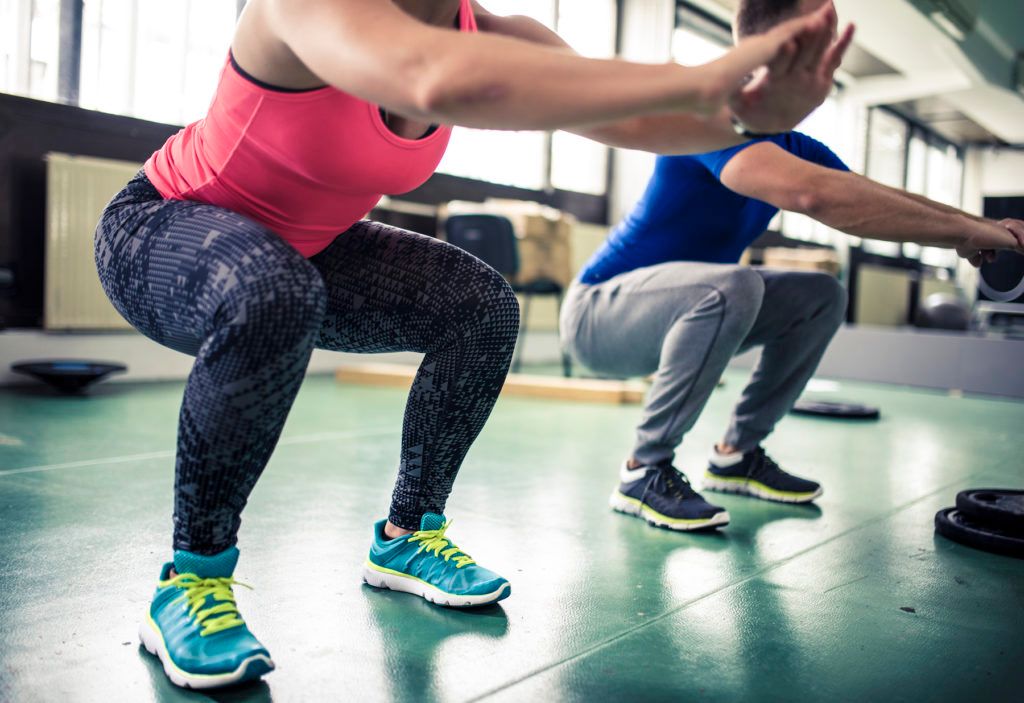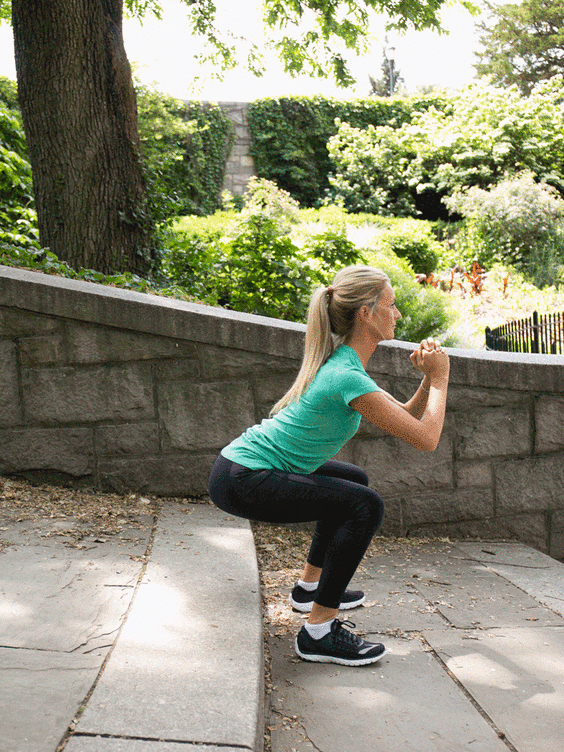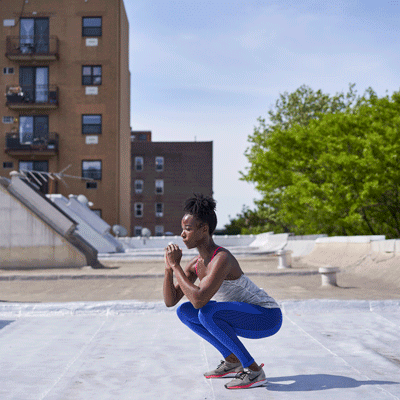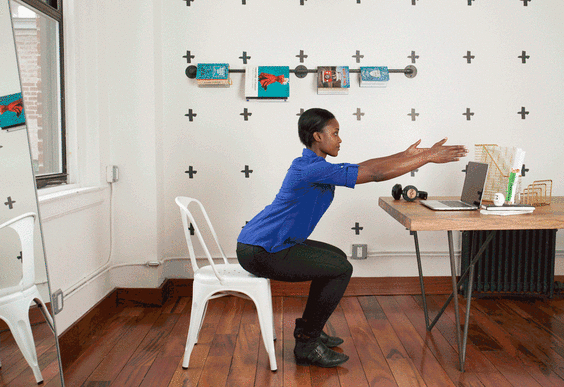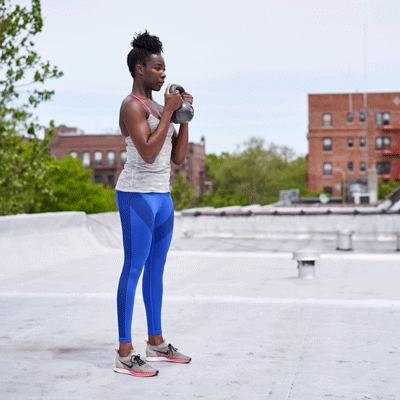In some fitness circles, they’re dreaded. In others, they’re revered. But whether you’re a fan or not, it’s hard to avoid squats in any well-rounded workout regimen.
And there’s a good reason for that: Squats are beneficial.
What are the benefits of squats?
Squats fall into the category of fundamental movements. That means they work the muscles you use to perform everyday movements: standing, sitting, walking, running, and lifting.
Standard squats and squat variations work your quads, glutes, hamstrings, and calves. They also engage your hip, knee, and ankle joints. The bonus: Squats burn calories.
BUTT (did you see that big butt thrown in there?) squats and improper form are a no-no combo. Without good form, you could injure yourself and ultimately miss out on some of the move’s benefits.
We consulted NASM-certified personal trainer Katelyn Barrons to get the lowdown on the benefits of this exercise, including favorite variations and some of the mechanical nuances that can affect your form.
Here’s how to do a few of the top squat variations and why they’re worth it.
Standard squat
It’s best to start with the basics and work your way up. Think of standard squats as a springboard into other squat variations. But don’t jump off that board until you’ve mastered good form.
- Stand with feet shoulder-width apart.
- Keep your back straight, squeeze your glutes, and pull shoulder blades toward each other to correct your posture.
- Hold your head in a neutral position (neck in line with your spine) and gaze forward.
- Sit into the squat like you’re sitting in a chair. It should feel like you’re pressing your feet through your heels into the floor. Keep knees in line with your second and third toes.
- Squat until your quads are parallel to the floor, then return to the starting position, pressing through your heels and squeezing your glutes at the top.
- Repeat.
Pro tip: Don’t let your knees fall inward or lean your torso too far forward. A forward tilt can put more weight on your toes, which is harder on your knees. Really press through your heels to keep your weight centered and your upper body upright.
The benefit: These work most of the muscles in your lower body, providing gains in strength and tone. Sets and reps will vary, but according to Barrons, starting with 3 sets of 5 reps and working your way up to 3 sets of 10 reps is a good plan. For a challenge, try fewer sets and higher reps or add weight with a barbell, dumbbells, or kettlebells.
Jump squat
- Stand with feet shoulder-width apart and prep your glutes and shoulders just as you did for the standard squat.
- Sit into the squat until quads are parallel with the floor.
- Using your quads, glutes, and hamstrings, push off the floor and jump.
- Extend your knees, hips, and ankles, pointing your toes. (Your toes should be a few inches off the floor.)
- Land on the balls of your feet with soft knees, letting knees absorb the impact.
- Repeat.
Pro tip: Make sure to maintain good form on the landing — don’t let your knees fall inward. You can create a cardio boost by letting one jump squat lead into the next.
The benefit: Jump squats are an explosive plyometric move that increases speed and agility. If you want to add intensity to your workout, jump (literally) into this variation. But it’s definitely an advanced exercise. If you’ve got knee or ankle issues, maybe move on to the next one.
Box (or chair) squat
Box squats are basically standard squats with your booty touching a box, chair, bench, or any other comparable seating apparatus of your choosing.
- Choose a box that allows you to squat until just above where your form collapses. For some, that’s right at chair height, where your thighs are parallel to the floor. You can go beyond parallel if you can do it comfortably, but don’t do that if it stresses your knees or if you can’t maintain good form in your upper body.
- Start with the same form as you would for a standard squat.
- Squat down, pulling shoulder blades toward spine, until your butt touches the box.
- Return to the starting position.
- Repeat.
Pro tip: You can increase or decrease the difficulty by changing the box height.
The benefit: Box squats help you work on hip flexibility/depth and strength at the bottom of the squat.
Sumo squat
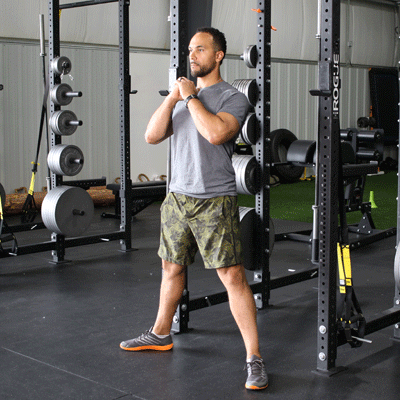
- Stand with feet several inches wider than hip width and toes facing outward at the same angle as your knees.
- Tighten your glutes and abs while keeping shoulders pulled back toward spine.
- Sit into the squat until your quads are parallel with the floor.
- Return to the starting position and squeeze your glutes at the top.
- Repeat.
Pro tip: You can add difficulty by holding a weight in front of you, combining a sumo squat with a goblet squat.
The benefit: The wider stance of sumo squats activates your inner thighs and makes them scream for mercy. But the results are worth it.
Goblet squat
“Similar to a barbell front squat, a goblet squat engages your anterior chain, or front muscles, which is why you feel more core activation than a back squat,” says Barrons.
- Start with the standard squat form, but hold a dumbbell or kettlebell with both hands at chest height.
- Tighten your abs and keep shoulders pulled back and chest high as you start to descend into the squat.
- Keep the weight close to your chest.
- Squat until your quads are parallel to the floor (sink deeper for added difficulty).
- Return to the starting position.
Pro tip: If your upper body leans too far forward during this squat, you’ll feel it (not in a good way) in your lower back. You have to use your core to keep your body upright while squatting. Also, be sure to tighten your glutes at the start and end of the squat.
The benefit: Barrons notes that if done right, the goblet squat works your upper bod just as much as your lower bod. “There’s also less stress on the spine in this position, which makes it a great choice for anyone with back issues,” she says.
She adds, “Doing goblet squats with a resistance band around the knees is a great way to add a little extra engagement in the glutes or to help beginners fix knee valgus (knees caving inward).”
Speaking of resistance bands…
Banded squat
Want to up the squat difficulty before increasing the weight of your squat? Add resistance bands.
- Stand with feet shoulder-width apart and a resistance band around your legs just above your knees.
- Perform a standard squat, making sure knees don’t fall inward and upper body doesn’t lean too far forward.
- Lower until thighs are parallel to the floor, then press back up to the starting position. (Squeeze your butt at the top!)
Pro tip: You can add resistance bands to any of the other squat variations to increase the difficulty before adding weight.
The benefit: Resistance bands add, well, resistance to the squat from the very first cheek squeeze. They’re a great way to prevent your knees from falling inward, because the band forces you to actively press against it.
Form is everything
You’ve prob heard it a million times, but it bears repeating: Don’t cheat on your form. (Looking at the ones packing on the weight plates without having done a squat in their life.)
Though it may be tempting to skip the beginning squat stages and go straight for what you think will get you gains, that can be the quickest way to hurt yourself. Be patient. Avoid the bar and weights until your form is solid.
As great as they may be, is it possible to overdo squats? Absolutely!
You can pull, strain, or sprain any of the muscles, tendons, and ligaments involved in squats. To protect yourself, don’t go all Arnold Schwarzenegger on your first try. Start with a standard squat before moving on to the more difficult variations, and gradually add reps, sets, and/or weight.
You can avoid overuse / too much weight / what-the-hell-am-I-doing-at-the-gym? injuries, but you have to be careful. Listen to your body. If you start to feel your muscles revolting, stop. Give yourself a day or two to recover before trying again.
You also have to think about muscle balance.
“The prime movers in a squat are the quads and the glutes,” says Barrons. “You want to make sure to do a similar quantity of hip hinge/deadlift movements that primarily work the hamstrings and glutes to spread out the volume in your lower-body muscles.”
Barrons recommends starting with one or two squat variations, once or twice per week.
Exercisers of all genders and ages can benefit from squats as long as they do the exercise with (let’s say it together) good form. But there are times when squats aren’t the best idea.
For example, if you’re coming off a knee injury or you have arthritis, you may need to modify your squat or use different exercises to target your lower body.
Barrons recommends that men work toward squatting 1–2x their body weight.
Women’s naturally wider hips can make it easier for their knees to fall inward, which is no bueno. Women also have a more forward-tilting pelvis than men. This tilt naturally puts weight onto the toes. Banded squats help prevent this, but Barrons says you don’t have to limit yourself to those.
“You will not get ‘bulky’ from squatting with a challenging weight. Instead, you’ll build strength, confidence, and look more toned,” she says. “Build your strength and ability gradually. Squatting 0.5, 0.75, or 1x your body weight can be an exciting and motivating goal to work toward.”
Squats are beneficial for folks of all ages and genders. They build strength in your lower-body muscles used for sitting and standing. They also strengthen your core, which helps with balance.
Form is everything! Concentrate on pressing through your heels to prevent leaning too far forward and putting extra stress on your knees. Practice your form with a standard squat before adding weight or trying a squat variation. It might be annoying to spend so much time on form, but it can save you from injury.
If issues like arthritis prevent you from reaching a thigh-parallel position, go down only as far as you comfortably can with proper form.
Have fun, and get your squat on!

